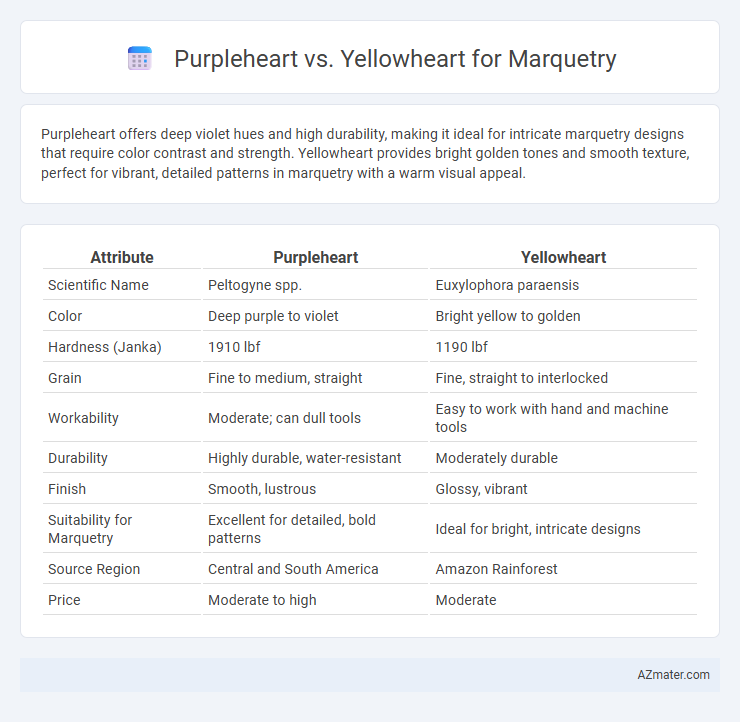Purpleheart offers deep violet hues and high durability, making it ideal for intricate marquetry designs that require color contrast and strength. Yellowheart provides bright golden tones and smooth texture, perfect for vibrant, detailed patterns in marquetry with a warm visual appeal.
Table of Comparison
| Attribute | Purpleheart | Yellowheart |
|---|---|---|
| Scientific Name | Peltogyne spp. | Euxylophora paraensis |
| Color | Deep purple to violet | Bright yellow to golden |
| Hardness (Janka) | 1910 lbf | 1190 lbf |
| Grain | Fine to medium, straight | Fine, straight to interlocked |
| Workability | Moderate; can dull tools | Easy to work with hand and machine tools |
| Durability | Highly durable, water-resistant | Moderately durable |
| Finish | Smooth, lustrous | Glossy, vibrant |
| Suitability for Marquetry | Excellent for detailed, bold patterns | Ideal for bright, intricate designs |
| Source Region | Central and South America | Amazon Rainforest |
| Price | Moderate to high | Moderate |
Introduction to Purpleheart and Yellowheart in Marquetry
Purpleheart and Yellowheart are prized hardwoods in marquetry for their vibrant, natural hues and fine grain textures. Purpleheart offers a deep purple to rich violet color that darkens with exposure, providing dramatic contrast and striking visual appeal. Yellowheart features a bright yellow to golden tone, adding warmth and brightness to intricate wood inlay designs, making both woods essential choices for high-quality marquetry work.
Botanical Origins and Availability
Purpleheart (Peltogyne spp.) is derived from tropical hardwood trees native to Central and South America, prized for its deep purple hue that darkens over time, making it ideal for marquetry projects requiring rich color contrast. Yellowheart (Euxylophora paraensis) comes from a rare hardwood species native to the Amazon rainforest, known for its vibrant yellow to golden tones and relatively limited availability due to sustainable harvesting concerns. Both woods offer unique botanical origins and color palettes, but Purpleheart tends to be more accessible commercially, whereas Yellowheart is valued for its rarity and bright, distinctive appearance in fine marquetry work.
Color and Visual Appeal
Purpleheart and Yellowheart differ significantly in color and visual appeal for marquetry. Purpleheart offers a deep, rich purple hue that darkens with age and exposure, providing a striking contrast and unique vibrancy. Yellowheart presents a bright, golden-yellow tone that remains consistent, lending warmth and a subtle elegance to intricate inlay patterns.
Workability and Cutting Ease
Purpleheart offers moderate workability with a fine, consistent grain that cuts cleanly but can dull tools faster due to its hardness, requiring sharp blades for detailed marquetry. Yellowheart is easier to cut and shape, featuring a coarse, straight grain that reduces tool wear and allows smoother, faster cutting without compromising precision. Both woods provide vibrant, contrasting colors ideal for marquetry, yet Yellowheart is generally preferred for projects demanding intricate cutting and less tool maintenance.
Tools and Techniques for Each Wood
Purpleheart requires carbide-tipped saw blades and sharp chisels due to its extreme hardness and density, ensuring clean cuts and reducing tool wear during marquetry. Yellowheart is slightly softer, allowing standard high-speed steel blades and fine gouges to achieve precision without excessive blade dulling. Techniques for Purpleheart emphasize slower cutting speeds and frequent tool sharpening, while Yellowheart permits faster work with consistent tool angles for smooth, intricate veneer patterns.
Glue and Finishing Compatibility
Purpleheart exhibits excellent glue adhesion due to its dense grain and oily texture, ensuring strong joints in marquetry applications. Yellowheart, while slightly less dense, also bonds well with common woodworking adhesives but may require careful surface preparation to avoid glue rejection. Both woods accept a variety of finishes, though Purpleheart can darken to a richer hue over time, whereas Yellowheart retains its bright yellow tone, influencing finishing choices in marquetry projects.
Durability and Stability Over Time
Purpleheart offers exceptional durability and resistance to wear, making it highly suitable for marquetry projects that require long-lasting stability. Yellowheart, while slightly softer, provides good dimensional stability with less susceptibility to warping or cracking over time. Both woods maintain their structural integrity well, but Purpleheart's denser fibers give it an edge in enduring heavy use and environmental changes.
Cost and Sourcing Considerations
Purpleheart, known for its vibrant purple hue, tends to be more expensive than Yellowheart due to its slower growth rate and limited availability, making sourcing more challenging. Yellowheart is generally more affordable and easier to source as it grows faster and is more abundant in Central and South American forests. Both woods require ethical sourcing practices to ensure sustainability and avoid legal restrictions in trade.
Best Applications and Design Suggestions
Purpleheart offers vibrant purple hues ideal for bold marquetry patterns in furniture and decorative art, providing strong durability and resistance to wear. Yellowheart's bright yellow tones complement lighter designs, perfect for intricate inlays and contrasting accents in cabinetry and musical instruments. Combining Purpleheart and Yellowheart enhances visual depth and color contrast, creating dynamic, eye-catching marquetry compositions that balance richness and brightness.
Conclusion: Choosing Between Purpleheart and Yellowheart
Purpleheart offers deep, vibrant purple tones with excellent durability, ideal for marquetry projects requiring bold color contrasts and long-lasting strength. Yellowheart provides bright, golden-yellow hues with a smooth texture, perfect for intricate patterns and a visually warm finish. Selecting between Purpleheart and Yellowheart depends on the desired aesthetic effect and the specific durability needs of the marquetry piece.

Infographic: Purpleheart vs Yellowheart for Marquetry
 azmater.com
azmater.com